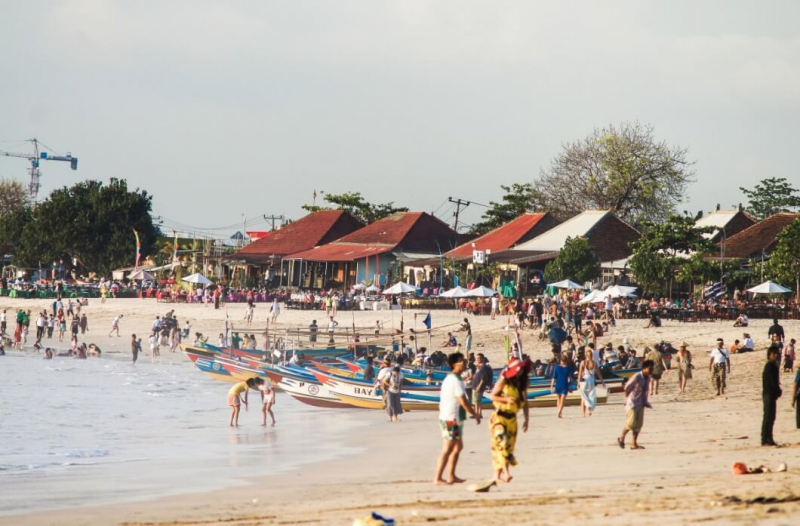Bali’s tourism paradise in 2024 saw over 6.3 million international tourists—a milestone that one might expect would bring celebration to an island where tourism drives so much of the economy. However, it has instead become a stark indicator that this beloved tropical escape is straining under the weight of its own popularity.
From the moment you arrive in Denpasar, the issues are obvious: lengthy traffic delays plague the route between the airport and Ubud, beaches are marred by plastic and endless rows of sunbeds, rice terraces suffer under the feet of Instagram seekers, and at revered temples, selfie sticks seem to outnumber actual offerings. A stretched out “tourist zone” that runs from Canggu through Seminyak, Kuta, and Ubud to the eastern cliffs now seems to absorb the majority of these arrivals, effectively transforming the island idyll into one of Southeast Asia’s most densely populated tourist areas.
Indeed, there’s a backlash. Some European and Australian tour companies are seeing booking declines for 2025-2026 relative to the post-pandemic highs of 2024. Travelers who once only dreamt of Bali are now inquiring about “the next Bali”—quieter, cleaner destinations such as Lombok, Sumba, or even Sri Lanka and the Philippines.
It’s Not Overtourism—It’s Lack of Control
The general consensus among local analysts, hoteliers, and even some government insiders points to this: Bali isn’t necessarily suffering from an overabundance of tourists; rather, it’s struggling with a distinct lack of proper management.
Unrestrained promotion: Despite Bali’s tourism paradise recognition, Indonesia’s Ministry of Tourism continues to aggressively pursue higher tourist numbers, often with insufficient consideration for the island’s capacity.
Administrative issues: Frequent leadership changes within the provincial tourism office, conflicting regulations, and inconsistent enforcement have contributed to a somewhat unregulated environment. Illegal villas pop up rather quickly, sometimes without appropriate permits or adequate wastewater management. Undocumented businesses—from uncertified yoga centers to clandestine bars—operate openly.
A questioned tourist tax: The 150,000 rupiah ($10) levy introduced in February 2024 was intended to fund conservation and cultural projects. However, Bali’s tourism office head, Tjokorda Bagus Pemayun, acknowledged that only roughly 35% of international visitors paid it in 2024. Collection is, well, uneven—some hotels collect it consistently, others don’t prioritize it, and the online portal itself can be unreliable.
The Expat Question
Long-term foreign residents—digital nomads, yoga instructors, villa owners, and retirees—are increasingly at the center of local tensions. While many offer important contributions to the economy, a small group have stirred resentment by disregarding visa regulations, undercutting local businesses, and transforming peaceful areas into party destinations. Reports of foreigners operating unauthorized retreats or bars with essentially no oversight have become hot topics in local media, fueling the perception that the culture and resources of the Bali’s tourism paradise are being commodified by outsiders who may not fully respect the island’s norms.
Click here to preview your posts with PRO themes ››

The Risk of a Death Spiral
Historically, destinations that fail to manage mass tourism effectively follow a downward trend: increased tourism means decreased satisfaction, and it leads to fewer repeat visits and less positive word-of-mouth with reduced willingness to spend and a race to the lowest prices and, as a result, attracting even more budget-conscious tourists to compensate. Bali appears to be showing the preliminary symptoms.
Hotels in Canggu and Ubud are reporting that average daily rates in shoulder seasons are already approximately 10-15% lower than 2023 levels in real terms, despite the rising cost of land and operations. Once top-rated beaches now often appear on “most disappointing” lists. Sacred sites, such as Tanah Lot and Besakih Temple, have instated strict visitor limits and timed entry—actions that come rather late for Balinese residents who might feel their own island has become a bit unrecognizable.
A Way Out—If Bali Acts Fast
Some degree of this, of course, is unavoidable. Destinations like Bhutan, which emphasizes high-value tourism with lower visitor numbers, or Palau, committed to stringent environmental standards, along with Iceland post-pandemic, illustrate that resolute political action and well-defined regulations can reshape tourism’s course.
As for Bali, the necessary actions are well-understood, although the political determination may still be lacking:
- Impose strict carrying-capacity limitations in the southern regions, and actively steer development toward the less-frequented north and east areas.
- Implement a compulsory and universal tourist tax, collected upon arrival at the airport without exception.
- Take firm action against unlawful building activities and visa violations—beginning with highly publicized cases to make a clear statement.
- Initiate a comprehensive dispersal plan: provide flight subsidies to less-developed regions, invest in infrastructure outside the southern area, and develop marketing initiatives that highlight the “other Bali.”
Grant local villages (banjar) the authority to reject major construction projects, reinstating a sense of local autonomy.
Until these actions are implemented, Bali will remain caught in a bind: its rising fame risks diminishing the very allure that initially made it famous.
The island continues to possess stunning natural beauty, welcoming inhabitants, and a distinct culture. However, tourism paradise is not limitless, and Bali is quickly running out of time to prove that it can protect what the world cherishes most about it.


